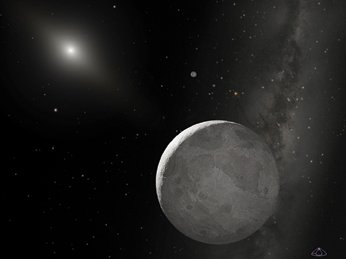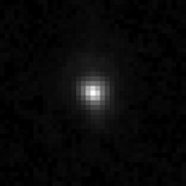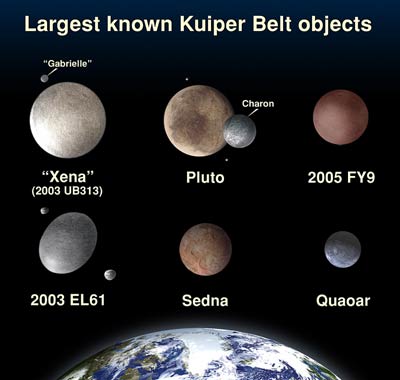Xena’s Mysterious Sparkle
Orbiting beyond Pluto, the recently discovered 10th planet reflects a lot of light.
By Emily Sohn
In addition to the nine planets that everyone learns about, there’s a 10th object in the solar system that’s tentatively being called a planet. Its name is Xena. It’s three times farther from the sun than Pluto is. And it’s surprisingly shiny.
 |
|
The distant sun shines on Xena, often called the 10th planet, in this illustration.
|
| NASA, ESA, and A. Schaller (for STScI) |
New images from the Hubble Space Telescope show that the unofficial planet measures 2,384 kilometers (1,490 miles) across. This makes it a little larger than Pluto, which is 1,422 miles wide.
Earlier observations from telescopes on the ground had suggested that Xena was considerably larger than this. It turns out, however, that Xena is much brighter than astronomers had estimated.
A distant object can look bright to an observer because it’s dim but has a large size (surface area) and so reflects a lot of light. Or, it can look bright because it’s small but has an especially shiny surface that reflects a lot of light. Xena belongs in the second category.
In fact, Xena reflects more light that any object in the solar system other than Saturn’s moon Enceladus. It reflects 86 percent of the sunlight that hits it. Pluto reflects only 60 percent of the sunlight that hits it.
 |
|
This Hubble Space Telescope image revealed Xena’s size for the first time.
|
| NASA, ESA, and M. Brown (California Institute of Technology) |
Scientists aren’t sure why Xena reflects so much light, but they have two theories. One idea is that the planet spews out methane gas, which freezes and keeps the surface covered with a blanket of fresh snow. For this theory to be true, something would have to be heating up the planet. So far, there’s no obvious source of heat.
The other idea is that Xena’s atmosphere is full of methane. This atmosphere forms when the planet is closest to the sun during its 560-year-long orbit. As the planet gets farther away from the sun, the methane freezes. But scientists aren’t sure whether the resulting frost would be bright enough to fully account for Xena’s special sparkle.—E. Sohn
 |
|
This illustration shows the largest known objects in the Kuiper Belt, which rings the sun at the fringes of the solar system. Pluto is usually considered to be a planet, and Xena has unofficially been called a planet. Not all of the smaller objects have names. |
| NASA, ESA, and A. Feild (STScI). |
Going Deeper:
Cowen, Ron. 2006. Brilliant! Tenth planet turns out to be a shiner. Science News 169(April 15):230. Available at http://www.sciencenews.org/articles/20060415/fob8.asp .
Information about Xena and its brightness is available at hubblesite.org/newscenter/newsdesk/archive/releases/2006/16/ (Space Telescope Science Institute).
Sohn, Emily. 2006. Saturn’s strangely warm moon. Science News for Kids (April 19). Available at http://www.sciencenewsforkids.org/articles/20060419/Feature1.asp .
______. 2004. Planets on the edge. Science News for Kids (April 7). Available at http://www.sciencenewsforkids.org/articles/20040407/Feature1.asp .







